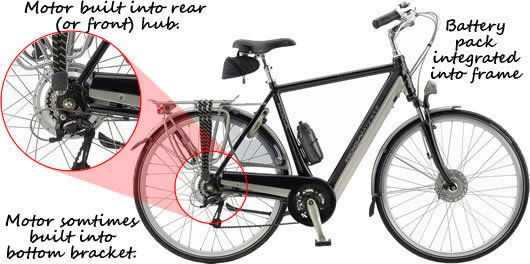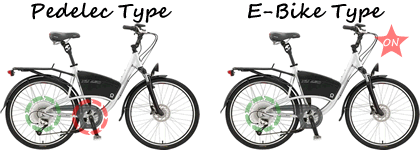Electric Bikes

General Description...
Electric bikes use a small electric motor driven by a rechargeable battery pack to help you along. They are good for hills, carrying lots of luggage, or making sure you don't arrive at work all hot and sweaty. The motors are not designed to replace your pedalling, just to assist it. There is a huge range available, but they generally fall into two categories:

A Pedelec typical control configuration is depicted on the left whilst on the right is an E-Bike typical control configuration
- E-bikes - These have a separate throttle on the handlebars, either a switch or a twist-grip like on a motorbike. You decide how much help you get from the motor.
- Pedelecs - These have a sensor on the pedals, and a little electronic brain measures how much effort you are putting in and decides how much extra help to give you.

A Pedelec typical control configuration is depicted on the left whilst on the right is an E-Bike typical control configuration
The legal stuff:
Electric bikes are still bicycles, so have no road tax, no insurance, no MOT, no license plates, etc. To comply with this, they have to be limited to a maximum speed under power of 15mph (although you can pedal faster than this if you want, of course) and an average power of 200W (250W for an electric tricycle). At present in the UK, both E-bikes and Pedelecs are covered by this, although there are moves to make E-bikes conform to the same regulations as mopeds.
The motor:
There are three ways that the motor can drive the bike - by rubbing a roller on the tyre, driving the chain (like you do when you pedal) or driving one wheel directly from the hub (as shown in the picture above). The first method works quite well in dry, dusty climates, but in the UK is not very effective. The second method is good, but you can sometimes find that you need to pedal in a gear which is good for the motor, not for you. The third method is generally the best.
The battery:
Some systems use Lead-Acid batteries (like in your car). These are good because they are very cheap, but they are also heavy and don't last very long - 150 uses is about it.
Nickel Cadmium (NiCad) batteries last a lot longer (1000+ uses) and are lighter, but are more expensive. NiCads are being phased out, due to EU pollition controls.
Nickel Metal Hydride (NiMH) are lighter still, but don't last so long (300 uses on average) and are a bit pricier than NiCads.
Lithium Ion (LiIon) batteries are the newest and lightest of all, and while there have been some concerns about overheating, they provide the greatest energy storage in the smallest package.
Nickel Cadmium (NiCad) batteries last a lot longer (1000+ uses) and are lighter, but are more expensive. NiCads are being phased out, due to EU pollition controls.
Nickel Metal Hydride (NiMH) are lighter still, but don't last so long (300 uses on average) and are a bit pricier than NiCads.
Lithium Ion (LiIon) batteries are the newest and lightest of all, and while there have been some concerns about overheating, they provide the greatest energy storage in the smallest package.
Pros...
If you want to be able to get out on a bike but need help on the hills, they are perfect. They are good if you would like to commute to work but haven't cycled for a while, or your work lacks changing and shower facilities.
Cons...
Electric bikes are typically heavier than other bikes, particularly at the cheap end of the scale. You have to carry around the extra weight of the batteries (basically a lump of lead in the case of cheaper Lead-Acid battery powered ones), so the bike can be hard to pedal without assistance, and to carry up stairs, for instance. The lightest electric bikes are currently around 13 1/2kgs (about 3.5KGs heavier than the host bike), utilising Lithium Ion battery packs, though cheaper electric bikes can be 15-20kg heavier, and in some cases even more.
Expect to Pay...
Add on motor packs start from around £300-350 with full electric bikes starting at about £600, but for a good one you should expect to pay around £1000+.
Image Copyrights
Images depict bikes manufactured by Koga Miyata and OHM (Not available to our knowledge in the UK).Electric bikes are available from a number of other manufacturers and use of Koga bicycle images is in no way an endorsement of their product for this purpose.
Permission for use of the images has been sought from Koga UK (AMBA Marketing) and copyright over these images remains with the respective supplier.

UK Electric Bike Law
Road Legality:
The law relating to this dates back to 1983, and covers what you can legally use on public roads in the UK.The limits are: 200W continuous power (250W for tricycles and tandems), 15mph maximum assisted speed, maximum weight 40kgs (60kgs for tricycles and tandems).
As long as your cycle is within these limits, and you are over 14, you can ride your bike legally on UK roads with no restrictions. This law is laid down in the Road Traffic Act, and the police have the power to enforce it.
Type Certification & Construction Regulations:
This covers what manufacturers build and sell - in that respect, it is similar to the old Kitemark or CE mark. This law has recently been revised and standardised across Europe, and is a matter for Trading Standards.Basically, all road vehicles are supposed to be Type Certified - this is a series of standards and tests the vehicle has to pass, like an MOT, but the manufacturer can get one certificate to cover all the bikes of one model they make.
Because this process is very expensive, there is an exclusion for some electric bikes, which do not need Type Approval. To avoid it, the cycle must be under 250W continuous power, 25km/h maximum assisted speed, and must have a pedal sensor which cuts the motor when the rider stops pedalling.
In addition, the UK also has regulations about the construction of electric bikes which are used on UK roads - basically, they have to be constructed to the same standards as non-electric cycles, to comply with BS6102 part 1.
So what is the situation for various bikes?
Some examples:What about kits?
The UK's road-legality legislation still applies - so you can have 200W continuous power (250W for tricycles and tandems), 15mph maximum assisted speed, maximum weight 40kgs (60kgs for tricycles and tandems). The whole Type Certification quagmire doesn't apply, however - the powers that be have decided that kits are outside their remit.